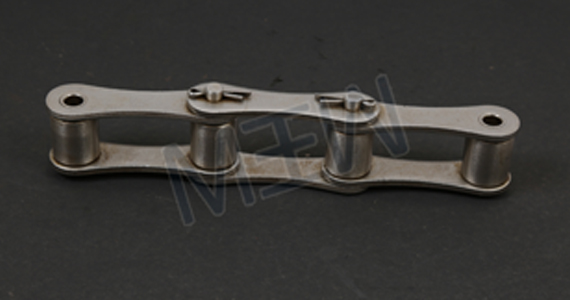Conveyor Chain
Introduction
Maniratan Machinery was established in the year 2017 and since 2020 it has been the Authorized dealer of Renold Chains. Maniratan Machinery is engaged in the manufacturing of Roller Chains, Conveyor Chains, Peg Chains, Stainless Steel Chains, Extended Pin/Rod Chains, Rubber Top Chains, and Biplanar Chains.
Additionally, we also manufacture customized chains based on the sample or picture provided by the customers.
One kind of chain made especially for moving items along production lines is a conveyor chain. To carry loads, it is made up of connecting links and attachments. Conveyor chains, which are frequently utilized in the food, packaging, and manufacturing sectors, provide robustness, effective material handling, and adaptable designs for a range of uses.
Key Features Of Conveyor Chain:
- High Load Capacity : Designed to transport heavy and bulky materials over long distances without deformation.
- Durability & Strength : Built with strong materials like alloy steel or stainless steel to withstand harsh working conditions.
- Corrosion & Heat Resistance : Special coatings or materials are used for operation in corrosive, wet, or high-temperature environments.
- Custom Attachments : Chains can be fitted with various attachments to suit specific material handling tasks (e.g., buckets, slats, rollers).
- Smooth and Reliable Operation : Precisely manufactured components ensure consistent, low-vibration movement.
- Low Maintenance : Minimal lubrication requirements and wear-resistant designs reduce downtime and maintenance effort.
- Wear Resistance : Surface-hardened pins and bushings extend operational life in high-friction environments.
- Flexibility in Design : Available in a wide range of pitches, sizes, and configurations for straight, curved, or vertical movement.
- High Tensile Strength : Can handle high-speed, high-stress operations without stretching or failure.
- Temperature Tolerance : Performs well in both freezing and high-temperature industrial settings.
Key Features Of Conveyor Chain:
- Extended Pin Conveyor Chain : Features pins that protrude beyond the link plates for attaching custom fixtures.
- Hollow Pin Conveyor Chain : Allows attachments to be bolted directly through the chain pin holes.
- Double Pitch Conveyor Chain with Extended Pins : Longer pitch with extended pins, ideal for light-duty conveying over long distances.
- Straight Side Plate Conveyor Chain : Flat side plates make it easy to mount guides and accessories.
- Attachment Conveyor Chain (e.g., A, K, SA, SK types) : Comes with integrated brackets or tabs for attaching custom components.
- Heavy Duty Extended Side Plate Chain : Thickened side plates for carrying very heavy loads.
- Top Roller Conveyor Chain : Features rollers on top of the links for smooth movement of goods.
- Side Roller Conveyor Chain : Rollers on the sides to reduce friction with guide rails.
- Flat Top Conveyor Chain : Chain with a flat surface, ideal for stable product transfer.
- Extended Bushing Conveyor Chain : Bushings protrude for special rotating attachments or guides.
- Drop Forged Rivetless Chain (Extended Version) : Rugged chain used in heavy applications like automotive and mining.
- Wide Waist Conveyor Chain : Provides extra surface area for high-load applications.
- Extended Sidebar Conveyor Chain : Longer sidebars to accommodate custom attachments and increase strength.
Maintenance and Guidelines and tips for Conveyor Chain:
Regular inspection, appropriate lubrication, adequate tensioning, and alignment checks are all part of Conveyor Chain maintenance. To get rid of waste and stop corrosion, chains should be cleaned often. Replace elongated or worn parts as soon as possible. In demanding applications, proper maintenance prolongs the chain's service life, guarantees smooth operation, and minimizes downtime.
- Choose the Right Chain Type : Select chain material, pitch, and attachments based on load, environment, and speed. Use stainless steel or coated chains in corrosive or food-grade environments.
- Proper Installation : Align sprockets and shafts correctly. Ensure correct chain tension (2–3% sag recommended). Avoid twisting or forcing the chain during installation.
- Regular Lubrication : Lubricate regularly, especially at the pin-bushing joint. Use the correct lubricant type (high-temp, food-safe, etc.) for the environment. Avoid over-lubricating, which attracts dirt and causes wear.
- Routine Inspection : Check for wear, elongation, cracks, rust, or deformation. Monitor noise, vibration, and chain movement—changes often signal problems.
- Monitor Chain Tension : Too tight: Increases stress and wear. Too loose: Causes skipping, vibration, and derailment. Adjust tension evenly across the drive.
- Keep the Chain Clean : Remove dust, sludge, or chemical residues that may accelerate corrosion. For food or pharmaceutical lines, follow hygiene protocols during cleaning.
- Use Correct Sprockets and Guides : Match chain and sprocket types and pitches. Replace worn sprockets to avoid premature chain damage.
- Avoid Overloading : Never exceed the chain’s rated load capacity. Overloading leads to chain stretch, deformation, and early failure.
- Use Protective Covers (if needed) : In dusty, wet, or chemical-prone environments, use guards or covers to shield the chain.
- Train Operators and Maintenance Staff : Educate staff on correct operation, inspection, and maintenance schedules. Keep maintenance logs to track chain performance over time.
Extended Pin Roller Chain Application Industries :
Conveyor chains are widely used across industries such as automotive, food processing, pharmaceuticals, mining, cement, packaging, and power generation. They enable efficient, reliable material handling in automated systems, even under heavy loads and harsh conditions.
- Automotive Industry
- Food and Beverage
- Pharmaceuticals
- Cement Industry
- Mining and Quarrying
- Steel and Metal Processing
- Textile Industry
- Pulp and Paper
- Power Generation
- Agriculture and Farming
- Packaging Industry
- Logistics and Warehousing
- Bottling Plants
- Electronics Manufacturing
- Construction Equipment

